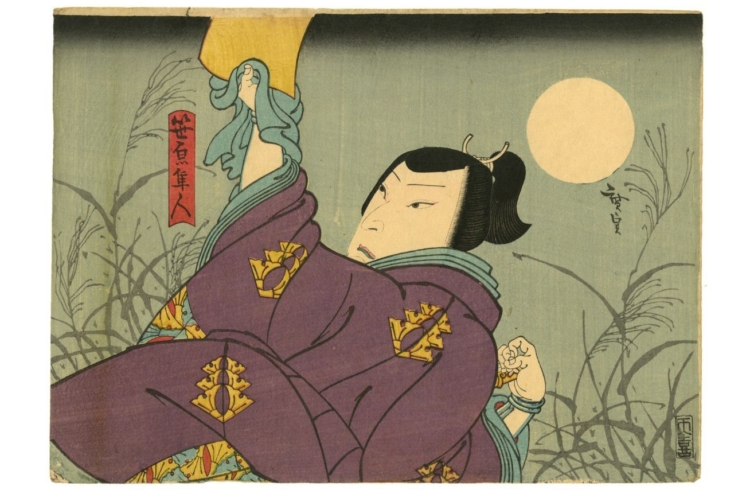- Exhibitions
- Shapes and Sizes. The Many Forms of Japanese Prints
Exhibition
Shapes and Sizes. The Many Forms of Japanese Prints
20 December 2024 – 16 March 2025

Size matters! In this groundbreaking exhibition,Japan Museum SieboldHuis presents the enormous variety in shapes and formats of Japanese printmaking.
To begin with, there are many types of Japanse printed matter. In addition to the well-known prints of Japanese landscapes actors and geishas, there are also multi-sheet compositons, fans, pillar prints, luxury square-shaped prints (surimono) and board games. Despite the limited size of the paper and woodblocks, publishers and printmakers managed to create an endless variety of printed matter. Get to know the history of Japanese printmaking and the art of handmade paper in this exhibition. Come face to face with works by such famous artists as Utagawa Hiroshige (1797-1858), Katsushika Hokusai (1760-1848) and Utagawa Kunisada (1786-1865).
Woodblock prints
The diversity of products made in Japan with the world-famous woodblock printing technique is immense. For centuries this technique has been used to print images and texts on paper. The woodblock printing technique has existed since the 8th century, yet it was not until the 17th century that commercial publishing flourished. This technique first focused on books, but around 1680 standalone prints also appeared. Initially these prints had erotic themes, some of which are also on display in this exhibition. Images of actors from the kabuki theatre and women from the entertainment districts were soon added. Eventually themes of landscapes, heroes, folklore and flora and fauna were included.

From left to right: Utagawa Hiroshige 歌川広重 (1797-1858), The iris garden at Horikiri, 5/1857, 24.5 × 36.6 cm. The plum orchard at Kameido, 11/1857, 24.7 × 36.6 cm. Maples at Mama, Tekona Shrine and the Connection Bridge, 1/1857, 36.9 × 25.5 cm. All from the René Scholten collection.
Japanese paper
Not only are the woodbocks and the quality thereof important in creating a print, an equally determining factor in the shapes and sizes of a Japanese print is the paper on which it is printed. Printmakers implemented innovative methods to make use of the properties and dimensions of the paper and create strikingly vivid compositions. For example, there are long, narrow prints that allow the viewer a fleeting look at an exciting scene, there are spectacular battle scenes with warriors that cover no less than six large sheets and there are upright formats that zoom in to such as degree that the image seems to escape from the paper. All these forms and formats are revealed in this versatile exhibition and shed new light on Japanese printmaking.
Don't miss this exhibition. Fall under the spell of the fascinating world of Japanese printmaking this winter!

From left to right: Kitagawa Utamaro 喜多川歌麿 (1753-1806) Oshichi and Kichisaburō, circa 1795-1800, 10 × 59 cm, Wereld Museum collection, RV-1330-62. Katsushika Hokusai 葛飾北斎 (1760-1849) An ancient view of the Yatsuhashi in Mikawa province, circa 1834, 37.1 × 24.1 cm, Paul Beliën collection. Suzuki Harunobu 鈴木春信 (1725?-1770) Bathing woman and a frog, circa 1770, 13.5 × 72.7 cm, Rijksmuseum collection, RP-P-2006-286. Tsukioka Yoshitoshi月岡芳年 (1839-1892) Kintarō wrestling with a giant carp, 7/1885, 25.5 × 74.5 cm, René Scholten collection.
Catalogue and activities
Bij deze tentoonstelling verschijnt een rijk geïllustreerde catalogus van de auteurs en gastconservatoren Jim Dwinger, Chris Uhlenbeck, Luisa Clark Homburg en Philo Ouweleen en met een voorwoord van directeur Kris Schiermeier.
This exhibition includes a richly illustrated catalogue by the autors and guest curators Jim Dwinger, Chris Uhlenbeck, Luisa Clark Homburg and Philo Ouweleen, with a foreword by director Kris Schiermeier.
This exhibition was made possible by: the Ministry of Education, Culture and Science, the City of Leiden, Leiden University, the Isaac Alfred Ailion Foundation, Takeda Nederland B.V., Leiden, City of Discoveries and the Friends of Japan Museum SieboldHuis.

Utagawa Yoshikazu (act. 1850-1870), Courageous warriors from The Chronicles of the Great Peace wage a bloody battle, 10/1856, 74.5 x 36.3 cm, Collection Japan Museum SieboldHuis, SH2018-DM-510






